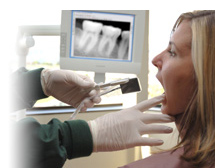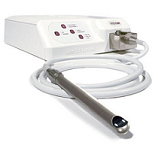|
SERVICES |
||
|
We are pleased to offer the following services and technologies to our patients:
Maintaining good oral hygiene is one of the most important things you can do for your teeth and gums. Healthy teeth not only enable you to look and feel good, they make it possible to eat and speak properly. Good oral health is important to your overall well-being. Daily preventive care, including proper brushing and flossing, will help stop problems before they develop.
In between regular visits to the dentist, there are simple steps that each of us can take to greatly decrease the risk of developing tooth decay, gum disease and other dental problems. These include:
The following are indications of good oral hygiene:
Back to top DENTAL CLEANING A dental cleaning is a professional cleaning you receive from a dentist or dental hygienist. Most dental cleanings take approximately 45 minutes. Cleanings should be performed every six months to prevent excessive plaque buildup. Plaque left untreated can lead to unhealthy gums and tooth decay. During your routine cleaning we will remove excess plaque and polish your teeth. HALITOSIS Halitosis is sophisticated word for “bad breath”. Depending on the cause, bad breath may strike on occasion or be a persistent condition. The most common cause of bad breath is bacteria. Because the mouth is moist and warm, it creates perfect conditions for the millions of bacteria that live in the mouth. In fact, approximately 80% of bad breath is caused by something in the mouth. Some types of bad breath, such as "morning mouth," are considered fairly normal and are not usually health concerns. However, persistent bad breath may be a sign of more serious problems with the gums and teeth. Bad breath may be caused by the following: Poor dental hygiene – poor oral hygiene can leave food particles to decay in the mouth. Infections in the mouth such as periodontal (gum) disease, respiratory-tract infections such as throat infections, sinus infections, lung infections. External agents including foods such as garlic, onions, and coffee, as well as cigarettes and chewing tobacco. Dry mouth caused by salivary gland problems or by breathing through the mouth. Systemic illnesses such as diabetes, liver disease, kidney disease, lung disease, sinus disease, reflux disease and others. Call our office promptly if you have bad breath with painful, swollen gums that bleed easily or loose teeth. We will perform a physical examination of your mouth to determine the cause. If we discover that systematic problems are the cause, we may refer you to your family physician. In severe cases of gum disease, we may recommend a specialized periodontist. Back to top Bonding involves adhering composite resin material that is matched to the color of the tooth, to the front of the tooth. This is performed to repair damage caused by decay, to alter the alignment of the tooth, close gaps between the teeth, or for other cosmetic purposes. First the surface of the tooth is roughened in order to accept the bonding. A gel is applied so the resin will adhere to the surface of the tooth. The composite is then placed on the tooth and the bonding agent hardens with intense light. The last step is shaping and polishing to give a lustrous finish. Back to top A filling is a way to restore a tooth damaged by decay back to its normal function and shape. If you have a tooth that requires a filling, the dentist will first remove the decayed tooth material, clean the affected area, and then fill the cleaned out cavity with a filling material. A filling helps prevent further decay by closing off any cracks or spaces where bacteria can enter. There are a variety of filling materials available including gold, silver, plastic and porcelain. The dentist will work with you to determine which material is best, depending on the extent of repair, where in the filling is needed, and cost. Each filling material is briefly explained below:
If decay or a fracture has damaged a large portion of the tooth, a crown (or "cap") may be recommended. Decay that has reached the nerve may be treated through root canal therapy or through a procedure called pulp capping. Back to top SEDATION DENTISTRY/DENTAL ANXIETY Dental sedation is a technique that can be used when a patient suffers from dental anxiety or dental phobia. We are happy to offer a number of solutions for our patients to make their dental visit as comfortable as possible. Sedation dentistry techniques enable patients who might otherwise avoid the dentist, to receive dental treatment necessary for a healthy smile. Depending on the extent of the anxiety or phobia, varying degrees of dental sedation can be utilized as described below. ORAL SEDATIVES This medication can be given to a patient the night before a dentistry procedure or 30 minutes to an hour prior to the dental appointment, depending on the severity of the anxiety. Oral sedatives do not provide pain relief, so an injection of local anesthetic will also be administered. The gums, ligaments, and bone around the teeth form the foundation for teeth. All structures are also referred to as the periodontium. When the periodontium is not healthy, it jeopardizes the teeth just as a bad foundation would threaten the stability of a house. Signs of unhealthy periodontium include: gums that are red and bleed easily, persistent bad breath, gums that are pulled away from the tooth, loose teeth, and changes in the position or bite of the teeth. With proper gum treatments, it may be possible to return gum tissue to a healthy state. If you're having a problem, come in and see us so we may treat it right away. The treatment usually involves a deep cleaning or root planing done under a local anesthetic, along with local antibiotic agents. It is important to have gum problems checked promptly, as gum disease left alone may eventually need treatment through surgery or extraction. Back to top |
|
CROWNS AND BRIDGES
Crowns and bridges are used to restore and enhance teeth that are damaged or to take the place of missing teeth. A crown (also referred to as a cap) is used to entirely cover a damaged tooth. A crown not only strengthens a tooth, but it can dramatically improve a tooth’s appearance, shape and alignment.
A bridge is an ideal method to fill the space created by missing teeth. A bridge is one or more artificial teeth cemented into place using the teeth on either side for support. This is an option for filling the space created by a missing tooth. Bridge work is as much an art as it is an exact science since it replaces a missing tooth both functionally and cosmetically. The materials used may be gold alloys, porcelain bonded to metal alloy, or all ceramic material made to match your natural tooth color. The choice of material depends on requirements for strength, wear, and aesthetics. Bridges and crowns are made by first taking an impression of your mouth. The impression is sent to a dental lab where your crown or bridge will be custom made to fit your mouth and match your natural tooth color. A temporary crown or bridge will be placed into your mouth until your permanent crown or bridge is ready and cemented into place. Bridges and crowns are very durable and can last a lifetime with extra care and good oral hygiene. Back to top
A dental implant is an ideal tooth restoration for people who are missing one or more teeth as a result of injury, periodontal disease, or any other reason. A dental implant is a metal post that a periodontist or oral surgeon surgically positions into the jaw. Once in place and bone surrounding the implant has had time to heal, a replacement tooth is attached to the post. While implants are typically more expensive than other methods of tooth replacement, they provide superior benefits. Implants are stronger than natural teeth and generally last 10-20 years. They are also a more favorable approach than bridgework since they do not depend on neighboring teeth for support. To receive implants, you need to have healthy gums and adequate bone to support the implant. You must also be committed to excellent oral hygiene and regular dental visits as these are critical to the long-term success of dental implants. Back to top DENTURES A denture is a removable replacement for missing teeth and surrounding tissues. There are two types of dentures available, including partial and complete dentures. Partial dentures are used when some natural teeth remain, while complete dentures are used to completely replace all teeth. Dentures are made to resemble your natural teeth so there should be no noticeable change to your appearance. In fact, dentures may even improve your smile! This restoration method is used to restore your smile and mouth function if all your teeth have been lost. The dentures are custom created to resemble natural teeth and are positioned to take the place of natural teeth. Complete dentures are removable and may require adjustments in order to create a proper fit with the gums and mouth. A removable partial denture is a device used when one or more natural teeth still remain in the upper or lower jaw. They usually consist of replacement teeth attached go a gum-colored plastic base which is held in place in the mouth. A fixed partial denture acts the same as a removable denture, but it is cemented into place using adjacent teeth for support. New dentures may feel awkward or loose for the first few weeks until the muscles of your cheek and tongue learn to keep them in place and you are comfortable eating and speaking. Although this may require some practice you will adjust and enjoy the benefits a full mouth of teeth can provide. NIGHTGUARDS AND MOUTHGUARDS Custom designed mouthguards and nightguards are made of plastic and molded to fit the shape of your teeth. Mouthguards are recommended to protect the jaw and teeth during physical activity and sports such as boxing, football, basketball, or other activities where your mouth may be hit. Guards also protect the soft tissues of your tongue, lips and cheek lining. Nightguards are recommended for patients who clench or grind their teeth at night as a way to protect their teeth and bite. If you have decided a guard is right for you, we will take an impression of your teeth which will then be sent to a lab to make a custom fit guard. In most cases you can choose from a variety of colors and styles. On average, guards last between 3 and 10 years.
TMJ TREATMENTS TMJ stands for temporal-mandibular joint. Temporal, as in temple area of skull; mandibular as in mandible, or lower jaw; joint as in where the head and jaw meet. Problems in this joint may be caused by a misalignment of the teeth, trauma, or excess muscle tension. Cartilage buffers the two bones and five muscles that meet in this area, but any problems in this area can create quite a bit of pain and biting difficulties. Symptoms of TMJ include:
Dental treatments for the condition can include replacing missing teeth, moving teeth, adjusting the bite and filling gaps between teeth. There is no one solution that is right for all cases. Occasionally a plastic mouthpiece is used to prevent clenching or grinding that is contributing to the problem. If untreated and in severe cases, surgery may be required to repair a badly damaged joint. |
|
Tooth whitening is a popular procedure to make teeth whiter and brighter, and therefore more attractive. Bleaching can be used to whiten stained and discolored teeth, or simply to enhance a dull smile. Either way, tooth whitening is a safe and relatively painless procedure ideal for most patients. Our office offers two methods of whitening: in-office whitening and tray whitening.
Tray whitening is a less expensive whitening treatment you can use while in the comfort of your own home. We will first take an impression of your mouth to create customized clear whitening trays for you to wear. Within a few days your trays will be ready to be picked up and we will show you how to apply the special bleaching material to the trays. The whitening gel trays should be worn 30-60 minutes up to twice a day. At the end of this period, you will see maximum whitening results that are nothing short of dazzling. Occasional treatment can be used at your convenience to maintain your new smile.
Veneers are a dental procedure in which a covering is placed over the outside (visible area) of the tooth. Veneers are usually only applied to the part of the tooth that is visible when talking or smiling. The procedure can be direct or indirect.
LUMINEERS can only be made from patented Cerinate porcelain unavailable anywhere other than the Cerinate Smile Design Studio. In just 2-3 visits to your LUMINEERS dentist, you can have a custom-made smile that is clinically proven to last over 20 years - and it is completely reversible since your natural tooth structure is still intact! Get your perfect smile today! Back to top |
|
In order to provide nothing but the best to our patients, our office uses state-of-the-art technologies in all our procedures. These new technologies allow us to treat dental cases with extreme precision, detect dental concerns at early stages, and provide stunning and customized restorations. When you visit our office you can be confident that you are receiving on the finest and most advanced in dental care. We proudly offer and use the following advanced equipment:
 gnose problems and disease. Without an x-ray of the whole tooth and supporting bone and gum tissues, there would be no way to detect infection or pathology that requires attention. gnose problems and disease. Without an x-ray of the whole tooth and supporting bone and gum tissues, there would be no way to detect infection or pathology that requires attention.
In our office we use digital radiography which allows us to take x-rays using up to 90% less radiation than conventional film x-rays. Using this technology, we are able to take an x-ray of your mouth by using a small sensor which records the image of your teeth and sends it to a computer. The result is a highly detailed image of your mouth that can easily be enhanced to better diagnose dental concerns and determine the very best treatment for each case. Back to top Air abrasion is a drill-less and more gental approach to remove decay from the teeth. An air abrasion unit is a small instrument that blasts a fine stream of air and particles onto the teeth to spray away decay. The small particles are made of silica, aluminum oxide or baking soda and aid in cleaning the tooth surface. Air abrasion allows for decay to quickly be removed while conserving healthy tooth structure. The particles and decay are then suctioned out of the mouth. Air abrasion is gentle because it generates no heat, sound, pressure or vibration. In addition, it reduces the need for anesthesia, making it an ideal choice for children and those who experience dental anxiety. Back to top ELECTRONIC CLAIM PROCESSING Our office utilizes electronic claims processing. This means that rather than sending your dental claim through the mail, it is sent electronically to your insurance company with the click of the button. By filing your claim electronically, information is submitted more efficiently and with fewer errors.This benefits our patients because the turn around time on claims is faster and fewer claims are returned or denied. We are happy to submit your dental claims to your insurance company on your behalf. Back to top INTRAORAL IMAGING We use small cameras about the size of a pen, called intraoral cameras, to help clearly see the condition of your teeth and gums. With this advanced technology we can zoom in on small diseased areas, cracks, chips and worn metal fillings with extreme precision. The full-color images taken with the intraoral camera are sent to a computer screen so we can clearly see and diagnose dental problems much earlier than with traditional dental technology. Because images are displayed on our screens, patients will also be able to see areas being worked on and are able to gain a better understanding of dental procedures being performed. Back to top |
|
 Brush thoroughly twice a day and floss daily
Brush thoroughly twice a day and floss daily · Gold fillings are custom made in a laboratory and then cemented into place. While gold fillings are often the most expensive choice, many consider it the best filling material. Gold inlays are well-tolerated by gum tissues and may last more than 20 years.
· Gold fillings are custom made in a laboratory and then cemented into place. While gold fillings are often the most expensive choice, many consider it the best filling material. Gold inlays are well-tolerated by gum tissues and may last more than 20 years.  Crowns may be used to:
Crowns may be used to:


